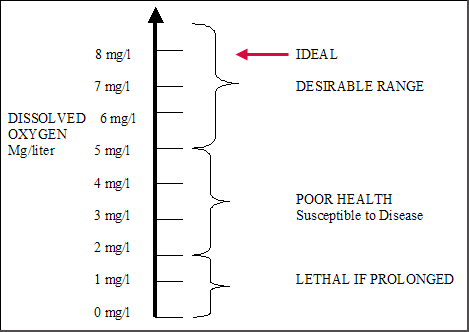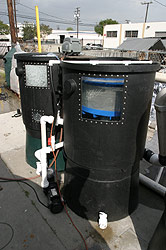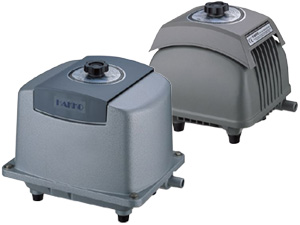 Active Koi consume 880 mg of O2 per kilogram of body weight per hour at 68 degrees F. After feeding the O2 demand increases. Active Koi consume 880 mg of O2 per kilogram of body weight per hour at 68 degrees F. After feeding the O2 demand increases.
The fish need a lot of oxygen to digest and grow. If there is only 8 mg/liter of oxygen in water, this 16 inch fish would consume all the oxygen in 110 liters (29 gallons) of water in one hour. Well, actually it could be near death in about 45 minutes or less.
Koi start to show oxygen deprivation stress with O2 levels around 5 mg/liter. Below 3 mg/liter (ppm), Koi will be severely distressed. If your fish require a minimum of 5 mg/l to maintain health and your pond only holds 8 mg/l, you only have 3 mg/l available as safety. Once the blood O2 and the water O2 drops, it takes considerable time to rebuild even after increased aeration. Oxygen deprivation is a precursor to disease. Fish exposed to chronic low levels of O2 will be prone to many diseases.

Oxygen is also being consumed by the bacteria in your pond filter or lake bottom. If your pond has a lot of organic waste build up, the bacterial decomposition process will remove more oxygen than the fish. This is called the Biological Oxygen Demand or BOD of water. A high level of waste will initiate a population explosion of bacteria to consume this waste. Your pond or lake would be considered to have a high BOD. A dirty pond with a high fish load can have an oxygen demand which exceeds the input of oxygen. Your aeration system may not be able to keep up with the demand.
Furthermore, with low oxygen the nitrifying bacteria will not be able to quickly break down the waste products and your fish will suffer further from ammonia and nitrite poisoning. The nitrification process decomposes organic waste into ammonia, nitrite and then nitrate. This process requires high levels of oxygen. Many hobbyists aerate the filter system for this reason. The biofilter will function at peak performance when fully aerated.
Insufficient oxygen will create an anaerobic (no oxygen) environment where toxic type bacteria can reproduce and release harmful gases like hydrogen sulfide or methane which are deadly to fish. The anaerobic digestion of waste is also a very slow process in lakes or ponds compared to aerobic digestion. These anaerobic waters will have increased build up of sludge and foul smelling gas and excessive algae growth.
 Algae, during the day produce oxygen through photosynthesis and can help to build O2 levels. However, at night the algae reverse the process and consume oxygen through respiration. This diurnal fluctuation can give you good oxygen levels during the day and dangerous low oxygen levels overnight. Fish seen gasping at the surface in the early morning hours are suffering from night time oxygen depletion by algae. This is especially seen when your pond has a “green water” bloom. Try to control your algae growth to minimize diurnal fluctuations. Proper algae control in lakes or ponds requires high levels of oxygen and circulation. Algae, during the day produce oxygen through photosynthesis and can help to build O2 levels. However, at night the algae reverse the process and consume oxygen through respiration. This diurnal fluctuation can give you good oxygen levels during the day and dangerous low oxygen levels overnight. Fish seen gasping at the surface in the early morning hours are suffering from night time oxygen depletion by algae. This is especially seen when your pond has a “green water” bloom. Try to control your algae growth to minimize diurnal fluctuations. Proper algae control in lakes or ponds requires high levels of oxygen and circulation.
Algae need carbon dioxide to grow. CO2 has been called a “heavy gas”. In ponds with too little aeration and circulation the CO2 tends to build up. Aeration and circulation helps to ventilate the carbon dioxide from the bottom of the pond into the atmosphere through surface turbulence. Carbon dioxide build up can actually interfere with oxygen’s ability to diffuse into the water. The CO2 takes up the space and O2 cannot fit. CO2 loves water and it takes a lot of surface turbulence to expel it into the atmosphere.

It is obvious by now that it is absolutely imperative that you maintain O2 levels near saturation at all times.
HAKKO air pumps can be a big boost to the success of your aquatic ecosystem. | 
